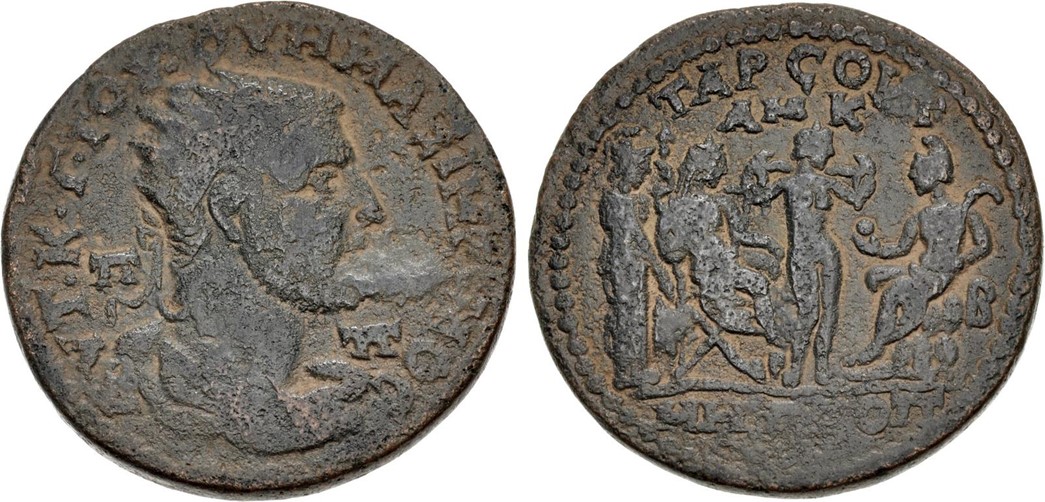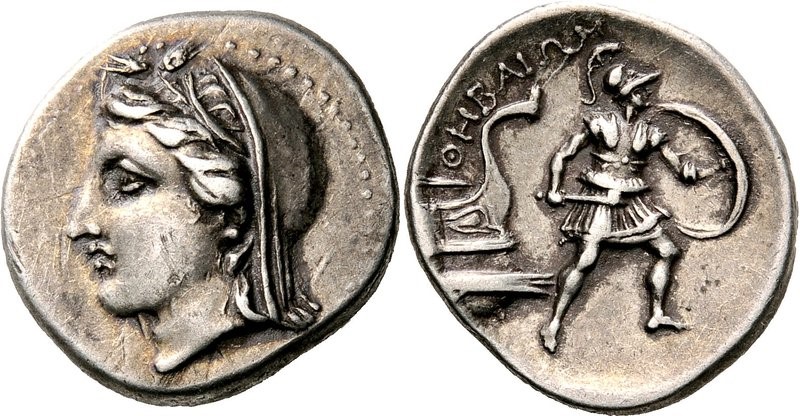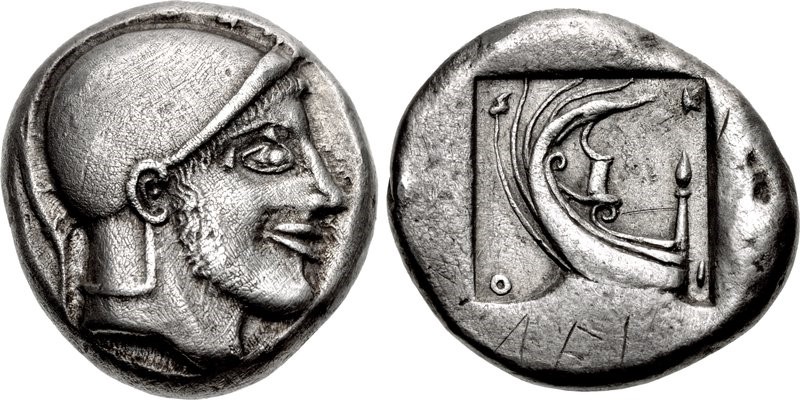NGC Ancients: The Trojan War
Posted on 10/15/2024
The Trojan War was an epic struggle in which Greek allies prevailed against the warriors of Troy, a fortified city that once was on the northwestern coast of modern-day Turkey. Scholars debate how much historicity there is to the war, but the ancient Greeks believed it took place around 1200 B.C., about six centuries before the invention of coins. The mythical stories associated with the Trojan War resonated in ancient literature, theater and art, and eventually found their way onto coinage, as well.
The spark for the Trojan War was the ‘Judgment of Paris.’ Zeus, the king of the Greek gods, held a wedding for the human hero Peleus and sea nymph Thetis (who later gave birth to Achilles). In revenge for not being invited to the wedding, Eris, the goddess of discord, threw a golden apple into the celebration with the inscription "To the fairest one." Three powerful goddesses – Hera, Athena and Aphrodite – each claimed the apple must have been intended for her, and they asked for a decision from Zeus. He wisely passed the task to someone else: Paris, the prince of Troy.
Paris is shown judging the claims of the three goddesses on the reverse of this base metal coin struck under Roman Emperor Commodus (Caesar, A.D. 166-177) in Ilium (Troas), a city thought to be the location of ancient Troy.
This base metal coin struck under Roman Emperor Maximinus I (A.D. 235-238) in Tarsus, Cilicia, also depicts the Judgment of Paris, as the prince of Troy holds the Apple of Discord. In their bid to win the apple and the title of fairest, Paris was offered a bribe by each of the three goddesses, with the prize going to Aphrodite.
Hera, the wife of Zeus, is shown on this silver stater struck ca. 370-350 B.C. in Argos in southern Greece, where she had a major following. Hera attempted to bribe Paris with power, vowing to make him king of Europe and Asia, if he would award the apple to her.
Athena, the goddess of wisdom and war, is shown on this silver tetradrachm struck ca. 134/3 B.C. in Athens, her namesake city. She offered Paris skill in warfare, a precious commodity in the ancient world.
Aphrodite, the goddess of love, is shown on this silver drachm struck late in the fourth century B.C. in Corinth. She offered the love of Helen, the most beautiful woman in the world. It was a bribe that Paris found irresistible.
The only catch was that Helen was already married to Menelaus, the king of Mycenaean Sparta. When Paris carried Helen off to Troy, Menelaus and his Greek allies demanded her return, sparking the Trojan War. This brass contorniate struck in the late fourth century A.D. likely shows Paris and Helen. The obverse shows Homer, a Greek poet in the seventh or eighth century B.C. who is credited with writing the Iliad, one of the earliest surviving works of literature, which recounts key events of the Trojan War.
The Greeks sailed to Troy, and this silver drachm or tetrobol struck at Thebai in Thessaly, ca. 302-286 B.C., shows the Greek warrior Protesilaus ready to enter battle. Protesilaus was the first Greek to die in the Trojan War.
Protesilaus is also shown on this silver tetradrachm struck ca. 480-470 B.C.in Scione in Macedon. According to one legend of the Trojan War, an oracle had predicted that the first Greek to set foot on land at Troy would also be the first to die. The Greek warrior Ulysses seemed to be the first onto the beach, and was then followed by Protesilaus, but Ulysses had thrown his shield down before stepping ashore, keeping his feet from touching land.
Accounts vary about who killed Protesilaus. One credits Hector, the commander of the Trojan forces and the brother of Paris. This base metal coin struck at Troy under Roman Emperor Caracalla (A.D. 198-217) shows Hector, the Trojans' greatest hero, standing in military attire.
The greatest hero on the Greek side was Achilles, and a prophecy had claimed that the Greeks could not win without his help. This base-metal trichalcon struck at Larissa Cremaste in Thessaly in the 4th century B.C. shows Achilles on the obverse and his mother, Thetis, seated on a hippocamp on the reverse. Thetis had dipped her son in the river Styx as an infant to make him invulnerable, though the water did not touch the heel by which she held him. It remained his weak point, hence the familiar term ‘Achilles heel’.
The Trojan War dragged on for years. This base metal medallion struck at Troy under Roman Emperor Valerian I (A.D. 253-260) shows the Trojan commander Hector with Greek ships in the background. The Greek hero Ajax the Great put up a heroic effort to fend off the Trojans and save the ships but, exhausted, he was disarmed by Hector.
Meanwhile, at the moment when he was most needed to save the Greek cause, the hero Achilles was sulking in his tent, bitter about loss of a female slave to the Greek leader Agamemnon. Achilles' friend Patroclus took matters into his own hands, donning Achilles' armor and emerging onto the field of battle to draw Hector into a showdown. This base metal coin struck in Troy under Emperor Commodus (A.D. 177-192) shows Hector in a biga, with a spear and shield.
Hector easily defeated and killed Patroclus, taking Achilles' armor as a war prize. Achilles' mother Thetis then persuaded Hephaestus, the god of blacksmiths and metalworking, to craft new armor for her son. Hephaestus is shown crafting the helmet on this base-metal medallion struck under Emperor Septimus Severus (A.D. 193-211) in Lydia, while Athena stands nearby with a spear and shield.
Achilles, furious over the death of his friend Patroclus, returned to battle and hunted down Hector, slaughtering him. Paris later avenged the death of his brother by killing Achilles with an arrow to his vulnerable heel.
En route to Troy, the Greeks had abandoned one of their wounded warriors, the renowned archer Philoctetes, on an island in the Aegean Sea. Learning of a prophecy that they could not win the war without his legendary bow and arrows, they returned and were surprised to find him still alive. He is persuaded to rejoin their cause and eventually slays Paris. Philoctetes is shown crouching with his bow on this base metal coin struck at Lamia in Thessaly in the fourth century B.C.
Late in the war, the Greeks learned that Troy was not destined to fall as long as it had its Palladium, a statue of Athena. Ulysses and Diomedes, one of the greatest Greek warriors, snuck into Troy to steal the statue. Diomedes is shown carrying off the Palladium on this silver drachm struck at Argos in Argolis in the 4th century B.C.
This bronze coin struck in Troy under Roman Empress Crispina (wife of Commodus) shows a closer view of the Palladium, at left on the reverse. Ilos founded the city of Troy after he followed a cow until it rested and prayed for a sign that he had chosen the correct spot. According to the city's founding myth, Zeus then sent him the Palladium.
Ulysses eventually crafted a daring and cunning plan to end the war: the construction of a giant wooden horse. It hid a small contingent of some of the greatest Greek warriors, including Teucer, who is seen earlier in the war being rescued by Ajax the Great (right) from Hector (left) on this bronze coin struck at Troy under Roman Emperor Caracalla. While the rest of the Greeks pretended to sail away, one stayed behind outside the horse to inform the Trojans that it was an offering to Athena and to trick them into bringing it into their city. At night, the Greeks emerged from the horse and opened the gate to their army, which destroyed the city.
Immediately after their victory, Ajax the Great and Ulysses quarreled over who should receive the powerful armor of Achilles. When it was awarded to Ulysses, Ajax the Great went insane with jealousy and plotted to kill the Greek leaders. Athena then clouded his mind, and he ended up killing a flock of sheep instead. Ashamed of his actions, Ajax took his own life, a scene portrayed on the reverse of this base metal diassarion struck at Prusa in Bithynia under the Roman Emperor Caracalla.
Ulysses' journey home took much longer than expected and is related in Homer's epic poem "The Odyssey." Among his misfortunes at sea is an attack on his crew by the sea monster Scylla, shown on this base metal contorniate struck in the late 4th century A.D.
When he finally returned home to his kingdom of Ithaca in western Greece after 20 years, Ulysses was recognized only by his dog Argos, a scene portrayed on the reverse of this silver serrate denarius struck under Roman moneyer C. Mamilius Limetanus in 82 B.C. Ulysses then proceeded to deal with the raucous crowd of suitors seeking to marry his wife, who had waited faithfully for him.
On the Trojan side, the hero Aeneas (a son of Aphrodite) was ordered by the gods to gather some of the survivors and flee his homeland. He is often shown carrying his father, Anchises, while leading his son Ascanius. This scene appears on a base metal semis issued at Troy in the late first century A.D. Aeneas and his companions eventually found their way to Italy, and his descendants were reputed to have founded the city of Rome.
The various tales associated with the Trojan War continued to captivate people's imagination long beyond ancient times. This Dutch Republic Rekenpenning – Jeton dated 1596 invokes the image of the Trojan Horse to celebrate the Dutch's rejection of peace negotiations. In modern times, computer programmers have given the name "Trojan virus" to malicious software that disguises itself as something helpful to trick an operator into installing it.
Images courtesy of Classical Numismatic Group.
Stay Informed
Want news like this delivered to your inbox once a month? Subscribe to the free NGC eNewsletter today!





















